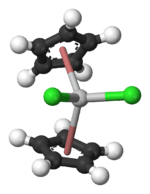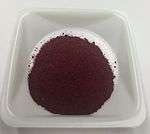Titanocene dichloride
 | |
 | |
 | |
| Names | |
|---|---|
| IUPAC name
Dichloridobis(η5-cyclopentadienyl)titanium | |
| Other names
titanocene dichloride, dichlorobis(cyclopentadienyl)titanium(IV) | |
| Identifiers | |
| 1271-19-8 | |
| 3D model (Jmol) | Interactive image |
| ChemSpider | 34981141 |
| ECHA InfoCard | 100.013.669 |
| PubChem | 5284468 |
| RTECS number | XR2050000 |
| |
| |
| Properties | |
| C10H10Cl2Ti | |
| Molar mass | 248.96 g/mol |
| Appearance | bright red solid |
| Density | 1.60 g/cm3, solid |
| Melting point | 289 °C (552 °F; 562 K) |
| sl. sol. with hydrolysis | |
| Structure | |
| Triclinic | |
| Dist. tetrahedral | |
| Hazards | |
| R-phrases | R37, R38 |
| S-phrases | S36 |
| NFPA 704 | |
| Related compounds | |
| Related compounds |
Ferrocene Zirconocene dichloride Hafnocene dichloride Vanadocene dichloride Niobocene dichloride Tantalocene dichloride Molybdocene dichloride Tungstenocene dichloride TiCl4 |
| Except where otherwise noted, data are given for materials in their standard state (at 25 °C [77 °F], 100 kPa). | |
| | |
| Infobox references | |
Titanocene dichloride is the organotitanium compound with the formula (η5-C5H5)2TiCl2, commonly abbreviated as Cp2TiCl2. This metallocene is a common reagent in organometallic and organic synthesis. It exists as a bright red solid that slowly hydrolyzes in air.[1] Cp2TiCl2 does not adopt the typical "sandwich" structure like ferrocene due to the 4 ligands around the metal centre, but rather takes on a distorted tetrahedral shape.[2] It shows antitumour activity and was the first non-platinum complex to undergo clinical trials as a chemotherapy drug.[3]
Preparation
Cp2TiCl2 continues to be prepared from titanium tetrachloride, in the same way as its original synthesis by Wilkinson and Birmingham:[4]
- 2 NaC5H5 + TiCl4 → (C5H5)2TiCl2 + 2 NaCl
The reaction is conducted in THF. Workup sometimes washing with hydrochloric acid to convert hydrolysis derivatives to the dichloride. Recrystallization from toluene forms acicular crystals.
Cp2TiCl2 can also be prepared by using freshly distilled cyclopentadiene:
- 2 C5H6 + TiCl4 → (C5H5)2TiCl2 + 2 HCl
This reaction is conducted under a nitrogen atmosphere and by using THF as solvent. The product is purified by soxhlet extraction using toluene as solvent.[5]
The complex is pseudotetrahedral. Each of the two Cp rings are attached as η5 ligands. Viewing the Cp ligands as tridentate, the complex has a coordination number of 8.
Applications in organic synthesis
Cp2TiCl2 is a generally useful reagent that effectively behaves as a source of Cp2Ti2+. A large range of nucleophiles will displace chloride. Examples:
- The Petasis reagent, Cp2Ti(CH3)2, is prepared from the action of methylmagnesium chloride[6] or methyllithium[7] on Cp2TiCl2. This reagent is useful for the conversion of esters into vinyl ethers.
- The Tebbe's reagent Cp2TiCl(CH2)Al(CH3)2, arises by the action of 2 equivalents Al(CH3)3 on Cp2TiCl2.[8][9]
Application in preparing sulfur allotropes
Titanocene dichloride is used to prepare titanocene pentasulfide, a precursor to unusual alloptropes of sulfur:
- Li2S5 + (C5H5)2TiCl2 → (C5H5)2TiS5 + LiCl

The resulting pentasulfur-titanocene complex is allowed to react with polysulfur dichloride to give the desired cyclosulfur of in the series:[10]
Reactions
Cp2TiCl2 undergoes anion exchange reactions, e.g. to give the pseudohalides. With NaSH and with polysulfide salts, one obtains the sulfido derivatives Cp2Ti(SH)2 and Cp2TiS5.
One Cp ligand can be removed from Cp2TiCl2 to give tetrahedral CpTiCl3. This conversion can be effected by with TiCl4 or by reaction with SOCl2.[11]
Ti(II) derivatives
Cp2TiCl2 is a precursor to many Ti(II) derivatives. Titanocene, TiCp2, is itself so highly reactive that it is not known but it can be trapped by conducting the reduction in the presence of ligands. Reduction of titanocene dichloride results in the fulvalene complex shown in the figure.

Reductions have been investigated using Grignard reagent and alkyl lithium compounds. More conveniently handled reductants include Mg, Al, or Zn. The following syntheses demonstrate some of the compounds that can be generated by reduction of titanocene dichloride in the presence of π acceptor ligands:[12]
- Cp2TiCl2 + 2 CO + Mg → Cp2Ti(CO)2 + MgCl2
- Cp2TiCl2 + 2 PR3 + Mg → Cp2Ti(PR3)2 + MgCl2
- Cp2TiCl2 + 2 Me3SiCCSiMe3 + Mg → Cp2TiMe3SiCCSiMe3 + MgCl2
With only one equivalent of reducing agent, Ti(III) species result, i.e. Cp2TiCl.
Alkyne and benzyne derivatives of titanocene are well known.[13] One family of derivatives are the titanocyclopentadienes.[14]
Titanocene equivalents react with alkenyl alkynes followed by carbonylation and hydrolysis to form bicyclic cyclopentadienones, related to the Pauson–Khand reaction).[15] A similar reaction is the reductive cyclization of enones to form the corresponding alcohol in a stereoselective manner.[16]
Reduction of titanocene dichloride in the presence of conjugated dienes such as 1,3-butadiene gives η3-allyltitanium complexes.[17] Related reactions occur with diynes. Furthermore, titanocene can catalyze C-C bond metathesis to form asymmetric diynes.[14]
Derivatives of (C5Me5)2TiCl2
Many analogues of Cp2TiCl2 are known. Prominent examples are the ring-methylated derivatives (C5H4Me)2TiCl2 and (C5Me5)2TiCl2. The ethylene complex (C5Me5)2Ti(C2H4) can be synthesised by Na reduction of (C5Me5)2TiCl2 in the presence of ethylene. The Cp compound cannot be made. This pentamethylcyclopentadienyl (Cp*) species undergoes many reactions such as cycloadditions of alkynes.[13]
Medicinal research
Titanocene dichloride was investigated as an anticancer drug.[18] In fact, it was both the first non-platinum coordination complex and the first metallocene to undergo a clinical trial.[3] The mechanism by which it acts is not fully understood; however, it has been conjectured that its activity might be attributable to the compound's interactions with the protein transferrin.[3][19]
References
- ↑ Budaver, S., ed. (1989). The Merck Index (11th ed.). Merck & Co., Inc.
- ↑ Clearfield, Abraham; Warner, David Keith; Saldarriaga Molina, Carlos Hermán; Ropal, Ramanathan; Bernal, Ivan; et al. (1975). "Structural Studies of (π-C5H5)2 MX2 Complexes and their Derivatives. The Structure of Bis(π-cyclopentadienyl)titanium Dichloride". Can. J. Chem. 53 (11): 1621–1629. doi:10.1139/v75-228.
- 1 2 3 Roat-Malone, R. M. (2007). Bioinorganic Chemistry: A Short Course (2nd ed.). John Wiley & Sons. pp. 19–20. ISBN 978-0-471-76113-6.
- ↑ Wilkinson, G.; Birmingham, J.G. (1954). "Bis-cyclopentadienyl Compounds of Ti, Zr, V, Nb and Ta". J. Am. Chem. Soc. 76 (17): 4281–4284. doi:10.1021/ja01646a008.
- ↑ Birmingham, J. M. (1965). "Synthesis of Cyclopentadienyl Metal Compounds". Adv. Organometal. Chem. 2: 365–413. doi:10.1016/S0065-3055(08)60082-9.
- ↑ Payack, J. F.; Hughes, D. L.; Cai, D.; Cottrell, I. F.; Verhoeven, T. R. (2002). "Dimethyltitanocene". Org. Synth. 79: 19.
- ↑ Claus, K.; Bestian, H. (1962). "Über die Einwirkung von Wasserstoff auf einige metallorganische Verbindungen und Komplexe". Justus Liebigs Ann. Chem. 654: 8. doi:10.1002/jlac.19626540103.
- ↑ Herrmann, W.A. (1982). "The Methylene Bridge". Adv. Organomet. Chem. 20: 159–263. doi:10.1016/s0065-3055(08)60522-5.
- ↑ Straus, D. A. (2000). "μ-Chlorobis(cyclopentadienyl)(dimethylaluminium)-μ-methylenetitanium". Encyclopedia of Reagents for Organic Synthesis. London: John Wiley.
- ↑ Housecroft, Catherine E.; Sharpe, Alan G. (2008). "Chapter 16: The group 16 elements". Inorganic Chemistry (3rd ed.). Pearson. p. 498. ISBN 978-0-13-175553-6.
- ↑ Chandra, K.; Sharma, R. K.; Kumar, N.; Garg, B. S. (1980). "Preparation of η5-Cyclopentadienyltitanium Trichloride and η5-Methylcyclopentadienyltitanium Trichloride". Chem. Industry: 288–9.
- ↑ Kuester, Erik (2002). "Bis(5-2,4-cyclopentadienyl)bis(trimethylphosphine)titanium". Encyclopedia of Reagents for Organic Synthesis. John Wiley. doi:10.1002/047084289X.rn00022.
- 1 2 Buchwald, S.L.; Nielsen, R.B. (1988). "Group 4 Metal Complexes of Benzynes, Cycloalkynes, Acyclic Alkynes, and Alkenes". Chem. Rev. 88 (7): 1047–1058. doi:10.1021/cr00089a004.
- 1 2 Rosenthal, U.; et al. (2000). "What Do Titano- and Zirconocenes Do with Diynes and Polyynes?". Chem. Rev. 33 (2): 119–129. doi:10.1021/ar9900109.
- ↑ Hicks, F. A.; et al. (1999). "Scope of the Intramolecular Titanocene-Catalyzed Pauson-Khand Type Reaction". J. Am. Chem. Soc. 121 (25): 5881–5898. doi:10.1021/ja990682u.
- ↑ Kablaoui, N. M.; Buchwald, S. L. (1998). "Development of a Method for the Reductive Cyclization of Enones by a Titanium Catalyst". J. Am. Chem. Soc. 118 (13): 3182–3191. doi:10.1021/ja954192n.
- ↑ Sato, F.; Urabe, Hirokazu; Okamoto, Sentaro (2000). "Synthesis of Organotitanium Complexes from Alkenes and Alkynes and Their Synthetic Applications". Chem. Rev. 100 (8): 2835–2886. doi:10.1021/cr990277l. PMID 11749307.
- ↑ WO 2004005305, Knox, R. J. & P. C. McGowan, "Metallocenes as Anti-Tumour Reagents", issued 2004
- ↑ Waern, J. B.; Harris, H. H.; Lai, B.; Cai, Z.; Harding, M. M.; Dillon, C. T. (2005). "Intracellular Mapping of the Distribution of Metals Derived from the Antitumor Metallocenes". J. Biol. Inorg. Chem. 10 (5): 443–452. doi:10.1007/s00775-005-0649-1.
Further reading
- Payack, J. F.; Hughes, D. L.; Cai, D.; Cottrell, I. F.; Verhoeven, T. R. "Dimethyltitanocene Titanium, bis(η5-2,4-cyclopentadien-1-yl)dimethyl-". Org. Synth. 79: 19.; Coll. Vol., 10.
- Gambarotta, S.; Floriani, C.; Chiesi-Villa, A.; Guastini, C. (1983). "Cyclopentadienyldichlorotitanium(III): a free-radical-like reagent for reducing azo (N:N) multiple bonds in azo and diazo compounds". J. Am. Chem. Soc. 105 (25): 7295–7301. doi:10.1021/ja00363a015.
- Chirik, P. J. (2010). "Group 4 Transition Metal Sandwich Complexes: Still Fresh after Almost 60 Years". Organometallics. 29 (7): 1500–1517. doi:10.1021/om100016p.
